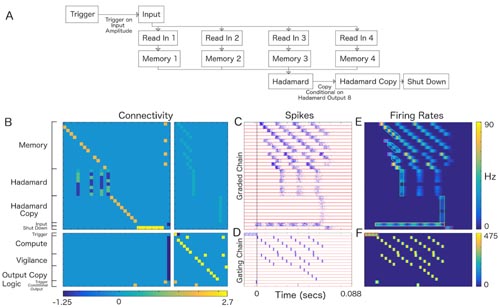检测到您当前使用浏览器版本过于老旧,会导致无法正常浏览网站;请您使用电脑里的其他浏览器如:360、QQ、搜狗浏览器的极速模式浏览,或者使用谷歌、火狐等浏览器。
 下载Firefox
下载Firefox
检测到您当前使用浏览器版本过于老旧,会导致无法正常浏览网站;请您使用电脑里的其他浏览器如:360、QQ、搜狗浏览器的极速模式浏览,或者使用谷歌、火狐等浏览器。
 下载Firefox
下载Firefox
/ 老版新葡萄8883官网 / 学术科研
新葡萄8883官网AMG陶乐天课题组近期在PLOS Computational Biology上发表了题为“Graded, Dynamically Routable Information Processing with Synfire-Gated Synfire Chains”的论文。该工作在脉冲门控同步放电链(pulse-gated synfire chain)的基础上,进一步提出了以同步放电链(synfire chain)本身的输出为门控的synfire-gated synfire chain(SGSC)模型。SGSC模型可以在多种不同情况下实现信息的稳定、精确传递,并可用于实现复杂的计算功能,为进一步理解大脑信息传递机制以及相关神经环路的设计提供了新的思路。
具有时空相关性的神经元放电及场电位信号存在于在多个脑区中以及脑区之间,被认为与大脑中信息的识别与传递有着紧密的联系。同步放电链(synfire chain)是一种用来描述这类放电活动的经典模型。然而,由于其自身动力学性质的限制,synfire chain只能传递“有或无”的二值化信息,不能传递具有多幅值的分层信息来实现更加复杂的计算功能。
陶乐天课题组在之前的研究中提出了pulse-gated synfire chain模型。该模型能够传递多幅值信息,揭示了在瞬态或振荡环境中,信息精确传递的动力学机制。与pulse-gated synfire chain相同,SGSC模型也可以实现信息的快速、分层传递。该研究通过平均场(mean-field)理论分析,揭示了当相邻层的门控电流在时间上有重合的情况下信息稳定传递的机制,并在SGSC模型模拟中得到了很好的验证。稳健性分析表明,SGSC在不同大小的神经网络中,以及在门控电流的时间或连接强度存在随机干扰的情况下,都能够稳定、精确地传递信息。

图1:利用SGSC实现精确的多幅值信号传递。
同时,该研究利用SGSC实现了一个可以根据输入信息幅值大小自动开启和关闭的复杂环路,可实时进行信息的记忆、处理、决策、复制等一系列复杂计算。由于SGSC模型的特性,使得我们在设计具有复杂计算功能的神经环路时,可以首先从算法的角度进行设计,然后将其依次在平均场模型及更真实的I&F神经网络中实现,为大脑或仿脑芯片中神经环路的设计及研究提供了新的思路。

图2:利用SGSC实现复杂计算回路。
生科院博士生王卓为本文的第一作者,加州大学戴维斯分校数学系教授Andrew T. Sornborger与陶乐天研究员为共同通讯作者。此项工作得到了国家自然科学基金委、科技部973计划、认知神经科学与学习国家重点实验室开放课题基金、北京市科学技术委员会、以及美国国立卫生研究院CRCNS项目的支持。
原文链接:http://journals.plos.org/ploscompbiol/article?id=10.1371/journal.pcbi.1004979
Abstract.
Coherent neural spiking and local field potentials are believed to be signatures of the binding and transfer of information in the brain. Coherent activity has now been measured experimentally in many regions of mammalian cortex. Recently experimental evidence has been presented suggesting that neural information is encoded and transferred in packets, i.e., in stereotypical, correlated spiking patterns of neural activity. Due to their relevance to coherent spiking, synfire chains are one of the main theoretical constructs that have been appealed to in order to describe coherent spiking and information transfer phenomena. However, for some time, it has been known that synchronous activity in feedforward networks asymptotically either approaches an attractor with fixed waveform and amplitude, or fails to propagate. This has limited the classical synfire chain’s ability to explain graded neuronal responses. Recently, we have shown that pulse-gated synfire chains are capable of propagating graded information coded in mean population current or firing rate amplitudes. In particular, we showed that it is possible to use one synfire chain to provide gating pulses and a second, pulse-gated synfire chain to propagate graded information. We called these circuits synfire-gated synfire chains (SGSCs). Here, we present SGSCs in which graded information can rapidly cascade through a neural circuit, and show a correspondence between this type of transfer and a mean-field model in which gating pulses overlap in time. We show that SGSCs are robust in the presence of variability in population size, pulse timing and synaptic strength. Finally, we demonstrate the computational capabilities of SGSC-based information coding by implementing a self-contained, spike-based, modular neural circuit that is triggered by streaming input, processes the input, then makes a decision based on the processed information and shuts itself down.